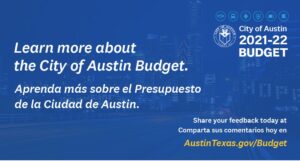
|
|
|
|
The Austin City Council has adopted a fiscal year 2021-2022 Budget. The all-funds budget, which includes enterprise departments as well as the core services provided by the General Fund, totals $4.5 billion, and The General Fund budget is $1.2 billion and the Capital Budget includes $1.3 billion in planned spending. Council’s adopted budget incorporates the bulk of the Austin City Manager’s proposals from last month, while adding a number of investments ranging across childcare, public safety and homelessness. “Council’s actions today provide a path forward to build on Austin’s many strengths while addressing the challenges we face as a city,” said Austin City Manager Spencer Cronk. “This Budget covers the increase in our base expenses, delivers our programs and services, and many of the critical reforms that our citizens want and that Council has prioritized, with minimal year-over-year impact on the typical Austin ratepayer.” Budget Highlights The largest portion of the General Fund budget – about two thirds – is allocated to public safety. The remaining third consists of Parks and Recreation, Austin Public Health, the Library, Animal Services, the Housing and Planning Department, and other requirements. The City continues to reimagine public safety, with new curriculum Hundreds of City staff across 13 departments will continue the City’s response to the homelessness crisis, with tens of millions of dollars allocated for this ongoing effort. The FY22 budget also includes $2.4 million for 18 full-time employees to advance Project Connect, a transit plan that includes a rail system, a downtown transit tunnel and an expanded bus system. The team’s initial focus will be on design, environmental studies, permitting, utility coordination, and other requirements for two light rail lines. This budget provides investment in high-priority resilience projects to prepare for threats and guard against potential future emergencies. Projects include Impact on Taxpayers The approved property tax rate of 54.10 cents per $100 of taxable value is a 4.7% increase above the no-new-revenue Operations and Maintenance rate. The City tax bill for the typical homeowner – defined as the owner of a median-valued ($399,760) non- Under the adopted budget, typical rate payers will see no change to their Austin Energy and Austin Water bills and modest Taken together, the combined impact of tax, rate and fee changes would represent an increase, for the typical ratepayer, of 0.6% – an additional $28.12 per year or $2.34 per month. Thursday’s approval of City tax and spending plans for the fiscal year beginning October 1, 2021 comes after several months of stakeholder engagement – including an online survey.
This is the fourth year in which the proposed budget was organized by outcome area, and not strictly by City department, to reflect the priorities of the Austin community, using Council’s adopted Strategic Direction 2023 as a guide. The outcomes are Culture & Lifelong Learning, Economic Opportunity & Affordability, Government That Works for All, Health & Environment, Mobility, and Safety. Council began their deliberations on Wednesday working from the Manager’s proposed budget, (snapshot summary here) which included the following investments, now part of the adopted budget:
After the Manager presented his proposed budget in July, stronger-than-expected sales tax growth freed up an additional $8.9 million, providing a significant boost to City revenues. On Thursday, Council added the following commitments:
It will be some weeks before the Approved Budget document is published. |





